In the dynamic world of online content marketing, visuals play a pivotal role in capturing audience attention and driving engagement. As businesses and ad agencies strive to create compelling campaigns, the debate between using mobile devices and professional DSLR cameras for content creation has gained prominence. Both options have their merits, but which is better suited for your brand’s needs? Let’s explore the pros and cons of each approach to help you make an informed decision. Also, visit RedAsh Films’ website https://redashfilms.com/ to learn about the work we do in video production and marketing for companies.
The Case for Mobile Content Shooting
Mobile devices have revolutionized content creation, democratizing access to high-quality video and photo production. Here are some reasons why businesses might consider using mobile devices:
- Cost-Effective: High-end smartphones often come equipped with advanced cameras, making them a budget-friendly alternative to DSLR setups.
- Portability: Lightweight and compact, smartphones are ideal for on-the-go shooting, making them perfect for capturing spontaneous moments or behind-the-scenes content.
- Ease of Use: Smartphones are user-friendly, with intuitive interfaces and built-in editing tools that streamline the content creation process.
- Integration with Social Media: Mobile devices allow for instant sharing across platforms, enabling quick turnaround times for time-sensitive campaigns.
- 4K and HDR Capabilities: Modern smartphones can shoot in 4K and offer HDR modes, delivering impressive video quality for most online marketing needs.
Despite these advantages, mobile content creation has its limitations. Poor low-light performance, limited depth of field, and fewer options for lens customization can be challenges for businesses seeking professional-grade visuals.
The Power of Professional DSLR Camera Setups
While mobile technology has come a long way, professional DSLR cameras remain the gold standard for high-quality content production. Here’s why:
- Superior Image Quality: DSLRs offer larger sensors, which capture more light and detail, resulting in sharper and more vibrant visuals.
- Creative Control: With manual settings for shutter speed, aperture, and ISO, DSLRs provide unparalleled creative freedom.
- Lens Versatility: Interchangeable lenses enable a wide range of perspectives, from macro shots to wide-angle landscapes, giving your content a polished, cinematic look.
- Advanced Features: Professional cameras often include features like optical stabilization, high-speed autofocus, and slow-motion capabilities that enhance production quality.
- Scalability: DSLR setups can be augmented with professional lighting, audio equipment, and stabilizers, making them ideal for complex shoots.
However, DSLR systems can be costly, require specialized knowledge, and demand more time for setup and post-production, which might not align with every project’s budget or timeline.
Choosing the Right Tool for the Job
The decision between mobile and DSLR setups ultimately depends on the type of content, audience expectations, and campaign goals:
- For Quick, Informal Content: Mobile devices excel at creating authentic, relatable content like Instagram Stories, TikTok videos, or real-time updates. Their convenience and immediacy are unmatched for platforms that prioritize engagement over production quality.
- For Professional, Polished Campaigns: DSLR cameras are indispensable for projects requiring high production values, such as product commercials, brand films, or corporate documentaries. They convey a sense of professionalism and credibility that resonates with premium audiences.
Why Expertise Matters
Whether you opt for mobile or DSLR shooting, the key to impactful content lies in execution. A poorly lit video or shaky footage will fail to engage, regardless of the equipment used. This is where expert guidance comes into play. Companies like RedAsh Films https://redashfilms.com/ bring a wealth of experience in content production, seamlessly blending technical proficiency with creative storytelling. Their ability to adapt to the project’s requirements ensures that every frame aligns with your brand’s vision and marketing objectives.
Finding the Balance
In many cases, a hybrid approach works best. Mobile devices can complement DSLR setups by capturing supplemental footage or creating real-time snippets to build hype for the main campaign. By leveraging the strengths of both, businesses can maximize their reach and impact.
Conclusion
The choice between mobile content shooting and professional DSLR camera setups is not about which is better but which is more suited to your goals. For ad agencies and companies, understanding the nuances of each approach is crucial in crafting a cohesive and effective online marketing strategy. By investing in the right tools and collaborating with experienced partners like RedAsh Films (https://redashfilms.com/), you can create content that not only stands out but also drives results.
For More Details Email us at – info@redashfilms.com
Or Fill The Form On This Link – https://redashfilms.com/contact/

